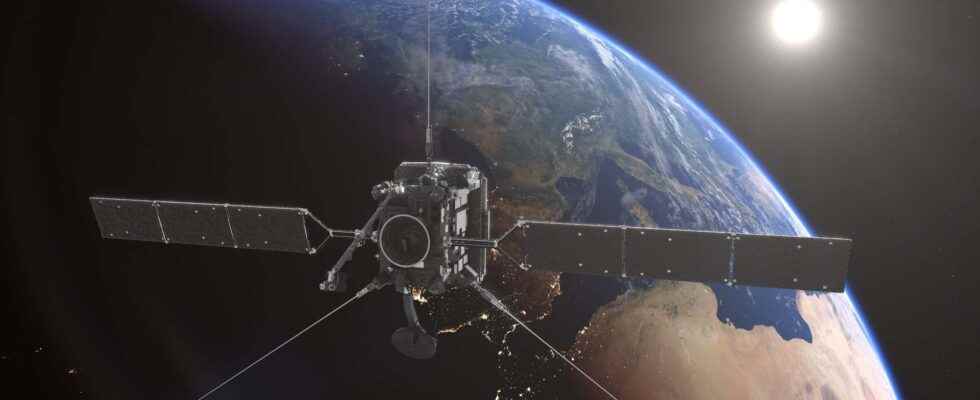The probability that the Solar Orbiter will encounter debris on its next flight over Earth is very low. But the risk is not zero, and the mere fact that this risk exists clearly reveals the disorder that reigns in space and the need to take measures to eliminate the space debris that swarms around our planet.
This Saturday, November 27, after one year and eight months of flight in the Solar System internal, the vessel Solar Orbiter will fly over its home planet, Earth, to reduce theenergy linked to her speed. The observation satellite will then be ready for the next six scheduled overflights of Venus. These last gravitational assistances will refine and tilt theorbit Solar Orbiter, allowing the protected probe from the heat to capture his very first direct images of the Sun’s poles, and much more.
During its flyover from Earth, Solar Orbiter is expected to pass 460 km from the surface at its nearest altitude, or about 30 km above the path of the Earth. International space station (ISS). It will cross the geostationary ring twice at 36,000 kilometers and will even pass below the level of low earth orbit, i.e. less than 2,000 kilometers, two congested areas of space debris.
What is the risk for Solar Orbiter?
Before we worry too much, let’s start by making it clear that the likelihood of the probe being struck by waste is really very low. Earth observation missions spend their entire lives in low Earth orbit, the most congested space junk area, and although they have to perform a few evasive maneuvers every year, Solar Orbiter will only stay a few minutes in this space. area before passing closer to the Earth’s surface and continuing towards Venus.
But even if the risks are low, collisions with garbage at a low Earth altitude are real. In 2016, a solar panel from the Sentinel-1A satellite of the’ESA, was struck by a particle estimated to be less than 5 millimeters in size. Despite its small size and due to its high relative speed, it damaged an area 40cm in diameter, resulting in a small drop in on-board power and small changes in the orientation and orbit of the satellite. . Hundreds of millions of garbage particles of this size are currently in orbit!
Hubble, the telescope NASA and ESA, the European Space Agency, have already spent 31 years in Earth orbit at an altitude of about 547 kilometers. During this period, he saw how the sky is saturated with satellites and garbage. He himself suffered the consequences, because his own solar panels were struck and damaged by small particles of waste.
Although the risk incurred by Solar Orbiter during its next flight over the Earth remains very low, it is not zero for all that. He was not exposed to this risk when he approached Venus. ESA’s Space Waste Office also did not need to perform a collision risk analysis when BepiColombo recently approached Mercury or when Cassini-Huygens flew over Jupiter.
Even during overflights of the Earth, for example when Cassini-Huygens flew over it in 1999, Rosetta in 2005, 2007 and 2009 and Juno once in 2013, there were fewer satellites, less garbage, and no “mega-constellations” in orbit. Although it remains safe, flying over Earth is riskier than in the past.
About 7-10 days before the overflight, ESA’s Space Waste Office will begin to do a risk analysis based on Solar Orbiter’s trajectory and the predicted position of objects listed as orbiting Earth. This will make it possible to calculate the probability of collision for a few specific close passages.
The cost of avoidance maneuvers
In these cases, if the uncertainty rate is high at the start, it decreases as the orbit of the objects evolves. The more imminent the moment of close passage becomes, the more our sighting data improves, which reduces the uncertainty as to the location of the debris concerned. As is almost always the case, the more information we have about the position of two objects, the more confident we are that they will cross each other safely.
But sometimes, as time passes and the moment of close passage approaches, the risk of collision increases. For each of the Sentinel missions in Earth orbit, a collision avoidance maneuver is performed, approximately once every five or six months, when the “avoidance distance” with another object is considered to be too risky.
For Solar Orbiter, in the unlikely event that it would be necessary to perform a maneuver to avoid an impact, the decision will be made this Thursday, November 25, two days before the close passage of the Earth. The maneuver would be executed on Friday, November 26, approximately six hours before this close passage.
Danger averted?
As soon as Solar Orbiter leaves close orbit to Earth and passes over thegeostationary orbit, he will be out of danger. The estimated time is about an hour after the time it will be at a minimum distance from Earth.
As the mission moves away from our Planet, with a little less energy than when it arrived, the satellite and its mission teams will never have to worry about space debris again. For missions still in Earth orbit, and for the next spacecraft awaiting launch, the situation in space is a growing source of concern.
After decades of launches without really worrying about the fate of satellites at the end of their life, our space environment is saturated with space waste. When Solar Orbiter is closest to us, momentarily crossing the highways of Earth’s orbit, it reminds us of an indisputable fact: the problem of space debris only concerns Earth, we created it and it is it’s up to us to clean up the space.
Interested in what you just read?
.
fs3
